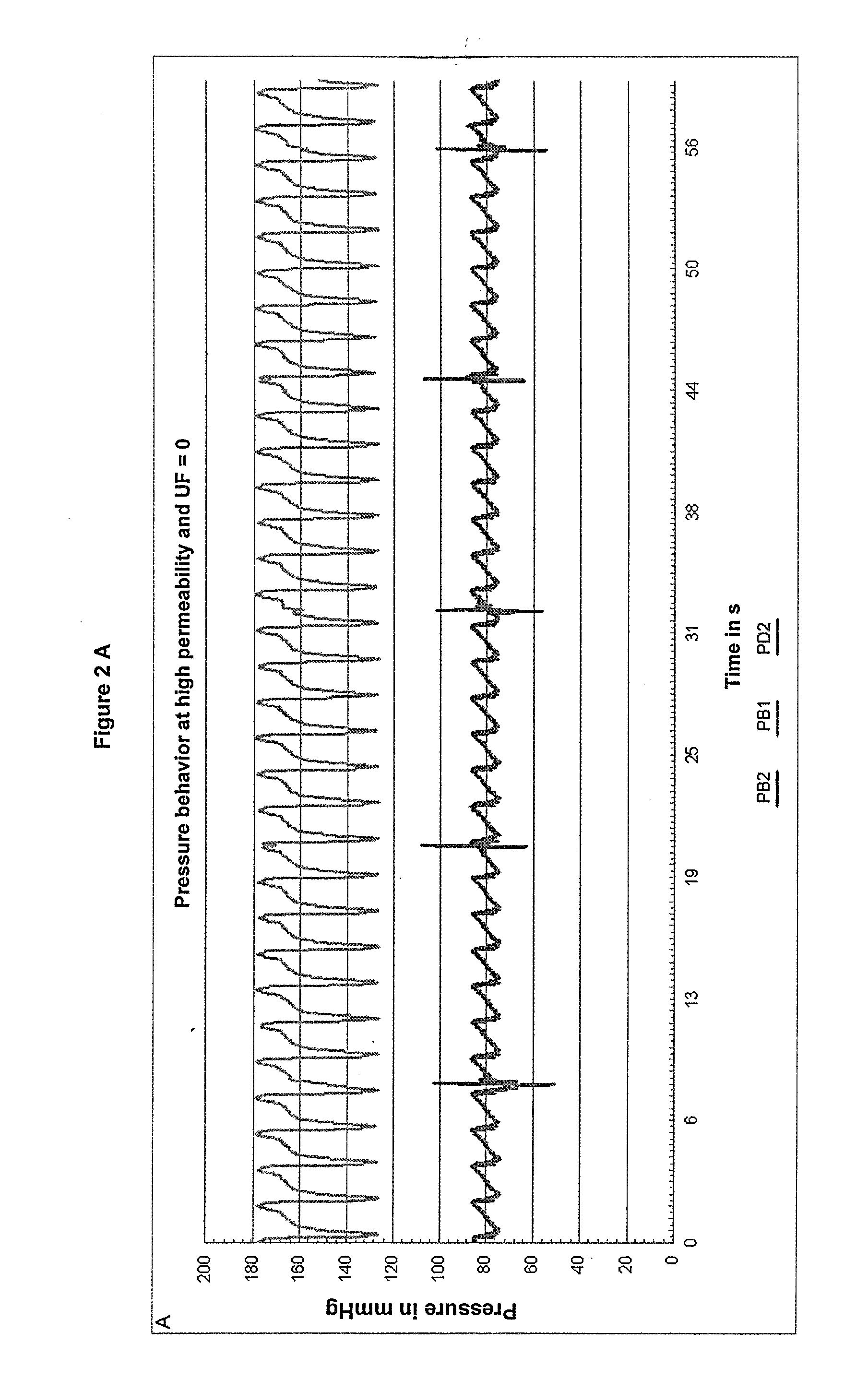Method and device for the measurement and the elimination of system changes in a device for the treatment of blood
a technology for blood and system changes, applied in medical devices, liquid/fluent solid measurement, medical informatics, etc., can solve problems such as limited, inaccurate detection of disturbances in the system, and changes in the pressure in the system, so as to and increase the dialysis efficiency and economic efficiency of dialysis
- Summary
- Abstract
- Description
- Claims
- Application Information
AI Technical Summary
Benefits of technology
Problems solved by technology
Method used
Image
Examples
example 1
Analysis of the Amplitudes of the Pressure Pulses
[0230]A periodic pressure progress is divided into individual pressure pulses and the amplitude of each pulse is determined from the minimum and maximum value. Therefore the periodic occurring minima of one pressure progress are determined. As a pressure pulse, a section from a minimum to the following minimum is considered. The width of the periodic pressure pulses is determined by the structure of the blood pump and the blood flow (BF). The pulse width is the same for all pressures and ultrafiltration rate (UF rate) at fixed BF, which however grow with increasing BF. For each pulse, the minimum and the maximum pressure are read. The amplitude is given by the difference of these extreme values. The ratios APD1 / APB1 and APD2 / APB1 as well as APD1 / AP B2 and APD2 / APB2 show a significant increase with increasing fiber permeability. This is clearly shown in FIG. 2. With increasing BF the pressure pulses increase, but ratios remain substant...
example 2
Analysis of the Phase Shift of the Pressure Signals
[0231]The pressure progresses can be approximated well in respect to the positions of the minima by a sine function with fixed frequency and phase shift. The frequency is identical for the respective pressures and is determined by the blood flow and the blood pump operating periodically, usually a peristaltic pump. The reciprocal of the frequency corresponds to the time width of an individual pressure pulse. Between the individual pressure progresses there is a phase shift, which is dependent, inter alia, on the permeability. The fill level of the bubble trap and the length of the tube system also have an influence and should therefore be kept constant during the measurements. With decreasing permeability, the phase shift of PB1 to PD1 and PD2 is larger, whereas that of PB1 to PB2 decreases.
[0232]During the use of a high-flux dialyzer (dialysis filter) with a hydraulic permeability of 275 ml / (h m2 mmHg) both PB2 and PD2 are shifted ...
example 3
Analysis of the Frequency Spectra of the Pressure Signals
[0233]The bases for calculation are the values of the complex amplitudes |cn| of the individual Fourier terms to the different frequencies according to
F(t)=∑-∞∞cn·(i·2·π·n·f·t)
(i=imaginary unit, n=counting parameters, f=frequency, t=time).
[0234]The amplitude values are normalized to the vector length proportional for the record time of the transformed signal in order to produce comparability.
[0235]The frequency spectra have a regular progress and show amplitude maxima in the basic frequency and integer multiples thereof. The frequencies are dependent on the blood flow. A doubling of the blood flow from 100 ml / min to 200 ml / min leads for example to a doubling of the basic frequency of about 0.27 Hz to 0.54 Hz. The amplitude value |cn| is greater for the pressures on blood side PB1 and PB2 with decreasing permeability and for the pressures on dialysate side (PD1 and PD2) it occurs inversely
[0236]In FIG. 4 it is shown how the per...
PUM
 Login to View More
Login to View More Abstract
Description
Claims
Application Information
 Login to View More
Login to View More - R&D
- Intellectual Property
- Life Sciences
- Materials
- Tech Scout
- Unparalleled Data Quality
- Higher Quality Content
- 60% Fewer Hallucinations
Browse by: Latest US Patents, China's latest patents, Technical Efficacy Thesaurus, Application Domain, Technology Topic, Popular Technical Reports.
© 2025 PatSnap. All rights reserved.Legal|Privacy policy|Modern Slavery Act Transparency Statement|Sitemap|About US| Contact US: help@patsnap.com



